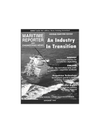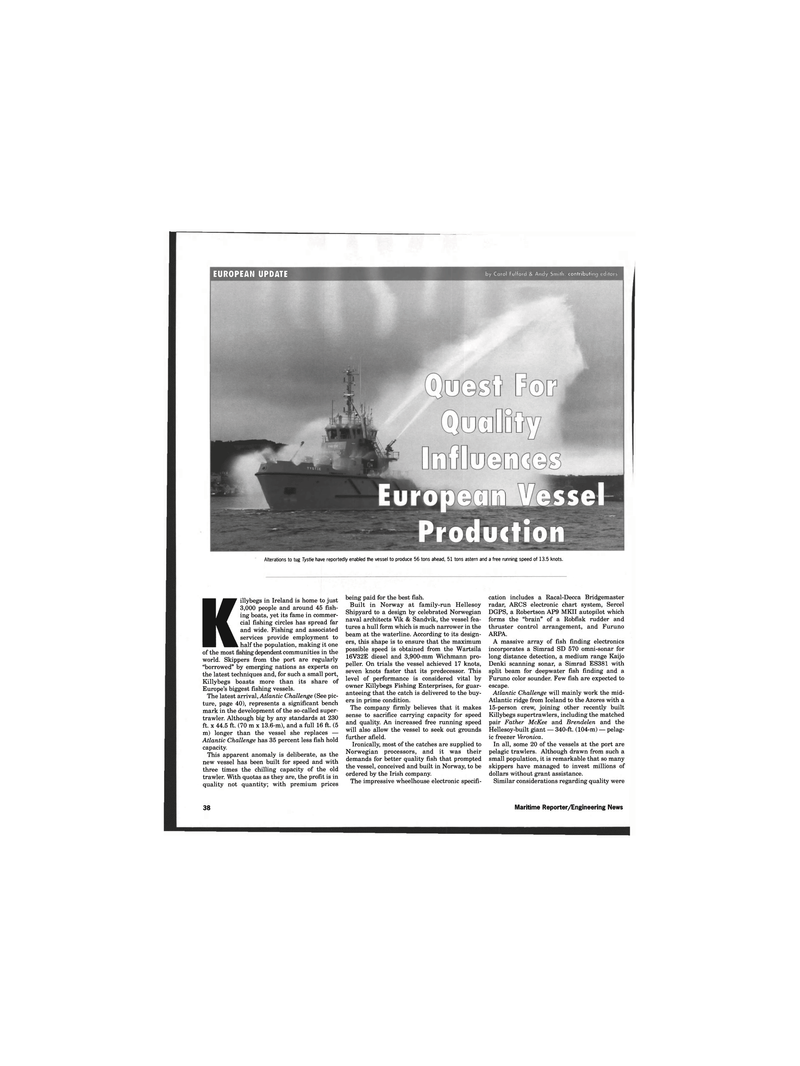
Page 38: of Maritime Reporter Magazine (September 1996)
Read this page in Pdf, Flash or Html5 edition of September 1996 Maritime Reporter Magazine
EUROPEAN UPDATE contributi
Alterations to tug Tystie have reportedly enabled the vessel to produce 56 tons ahead, 51 tons astern and a free running speed of 13.5 knots.
Killybegs in Ireland is home to just 3,000 people and around 45 fish-ing boats, yet its fame in commer-cial fishing circles has spread far and wide. Fishing and associated services provide employment to half the population, making it one of the most fishing dependent communities in the world. Skippers from the port are regularly "borrowed" by emerging nations as experts on the latest techniques and, for such a small port,
Killybegs boasts more than its share of
Europe's biggest fishing vessels.
The latest arrival, Atlantic Challenge (See pic- ture, page 40), represents a significant bench mark in the development of the so-called super- trawler. Although big by any standards at 230 ft. x 44.5 ft. (70 m x 13.6-m), and a full 16 ft. (5 m) longer than the vessel she replaces —
Atlantic Challenge has 35 percent less fish hold capacity.
This apparent anomaly is deliberate, as the new vessel has been built for speed and with three times the chilling capacity of the old trawler. With quotas as they are, the profit is in quality not quantity; with premium prices being paid for the best fish.
Built in Norway at family-run Hellesoy
Shipyard to a design by celebrated Norwegian naval architects Vik & Sandvik, the vessel fea- tures a hull form which is much narrower in the beam at the waterline. According to its design- ers, this shape is to ensure that the maximum possible speed is obtained from the Wartsila 16V32E diesel and 3,900-mm Wichmann pro- peller. On trials the vessel achieved 17 knots, seven knots faster that its predecessor. This level of performance is considered vital by owner Killybegs Fishing Enterprises, for guar- anteeing that the catch is delivered to the buy- ers in prime condition.
The company firmly believes that it makes sense to sacrifice carrying capacity for speed and quality. An increased free running speed will also allow the vessel to seek out grounds further afield.
Ironically, most of the catches are supplied to
Norwegian processors, and it was their demands for better quality fish that prompted the vessel, conceived and built in Norway, to be ordered by the Irish company.
The impressive wheelhouse electronic specifi- cation includes a Racal-Decca Bridgemaster radar, ARCS electronic chart system, Sercel
DGPS, a Robertson AP9 MKII autopilot which forms the "brain" of a Robfisk rudder and thruster control arrangement, and Furuno
ARPA.
A massive array of fish finding electronics incorporates a Simrad SD 570 omni-sonar for long distance detection, a medium range Kaijo
Denki scanning sonar, a Simrad ES381 with split beam for deepwater fish finding and a
Furuno color sounder. Few fish are expected to escape.
Atlantic Challenge will mainly work the mid-
Atlantic ridge from Iceland to the Azores with a 15-person crew, joining other recently built
Killybegs supertrawlers, including the matched pair Father McKee and Brendelen and the
Hellesoy-built giant — 340-ft. (104-m) — pelag- ic freezer Veronica.
In all, some 20 of the vessels at the port are pelagic trawlers. Although drawn from such a small population, it is remarkable that so many skippers have managed to invest millions of dollars without grant assistance.
Similar considerations regarding quality were 38 Maritime Reporter/Engineering News

 37
37

 39
39
